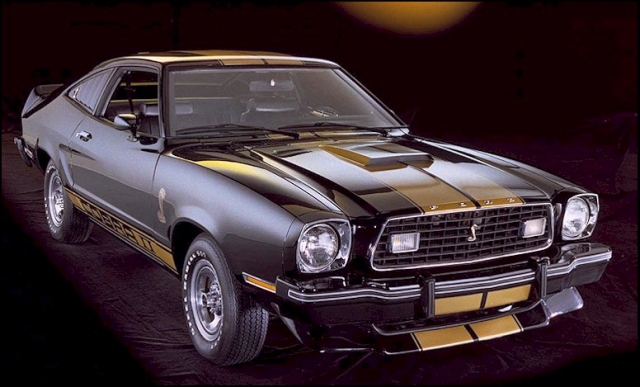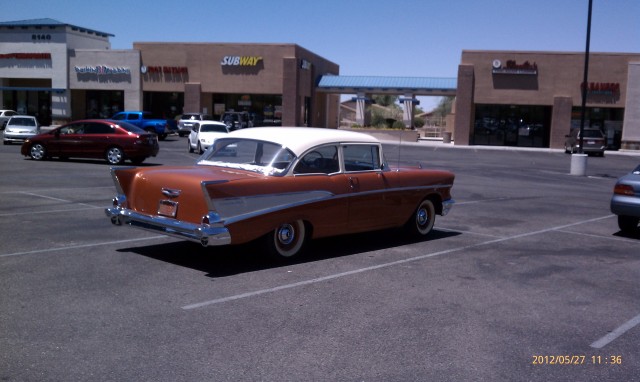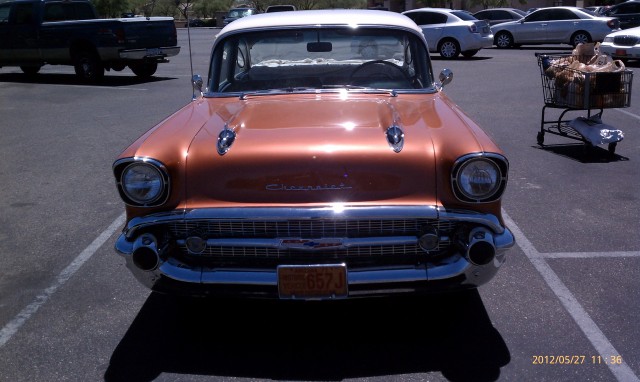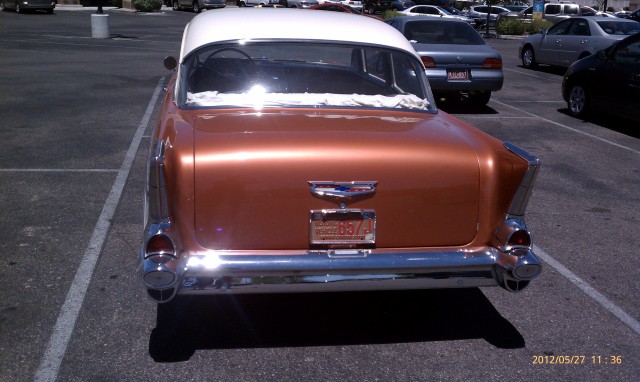

By Brian Earnest
At the age 89, it seems Susan Manherz’s friend Bud has managed to outlive all of his siblings and immediate family members. During his advanced years, Bud didn’t see many members of his clan, but there were a few of them around. As late as the 1970s, he had at least two other close relatives still kicking.
These days, though, Bud is a true octogenarian orphan, at least until a long-lost kin comes out of the woodwork. Bud is only a car — a 1923 American — but the way the Manherz family talks about its colorful personality, you’re not so sure.
“If you look at him, it looks like the car has lips!” Manherz joked. “He just has personality. You know, sometimes when you’re looking for a car and you see one, it’s like, ‘That’s the one.’
“I know it sounds crazy to some people… He’s a little cantankerous at times. And he can be difficult. That’s why he’s Bud. He’s just a car with a lot of personality.”


The 1923 American touring became an official member of the Manherz family back in 1990 when Susan and her husband, Mike, stumbled across the car at a now-defunct collector car dealership in Gaithersberg, Md. The couple hadn’t been looking for any car in particular, but the idea of a 1920s car sounded appealing and “my husband has an uncanny knack for sniffing out old cars,” according to Susan.
“I think the man had traded in three cars for a new Jaguar, and the American was one of them. We looked in the door and just saw the top of this touring car that stuck up above everything … of course they were closed that day, but the next day we went out there and we just kind of nabbed it then. We took him for a test drive and he needed some tinkering and stuff, but we knew right then that we wanted him.”
At the time, the couple had no idea how rare the car was or that they might never see another American. When they began doing some homework on their own car, and the American brand, they soon discovered that Bud was pretty much one of a kind. “In the 1960s there were three Americans known to exist, and all the owners knew each other,” Manherz said. “One was an earlier car that wouldn’t look anything like ours. It had a painted radiator shell and it was smaller. We haven’t been able to track it down. The man who had it died in the early ’70s and nobody knows what happened to the car. The [third] car was the same year as ours, but it was pretty much a parts car. It wasn’t complete. The guy who had it sold it, I know, and we’ve never found out what happened to it.”


Much to their delight, the Manherzes have been able to find out plenty about their own American, however. They are the fourth owners and they have been able to retrace much of Bud’s tire tracks prior to 1990.
“It was purchased new by Frank Ritter on June 9, 1923, from Adams Motor Company of Rochester, N.Y. We still have all the original manuals and correspondence that came with the car when new,” Manherz noted. “Each owner of the car knew the previous owner. I know the original story of how the second owner got the car, and his son is still living and I talk to him on the phone… He bought it in 1955 and it had been up on blocks since 1930. The car was always in New York until we bought it, so he’s lived his whole live where it’s cold.”
There have been many car-building companies with the patriotic “American” moniker in their titles. One of the more successful early ones was the American Motor Co. of Plainfield, N.J. The company built cars from 1916 to 1924 and was also called American Six and American Balanced Six. Louis Chevrolet was vice president and chief engineer of the company during its early days, and in 1918 the Americans carried an “O.K. Chevrolet” signature badge to show that they had passed muster with the boss.
The company merged with the Bessemer Truck Corp. in 1923 and became the Passenger Car Division of Bessemer-American. That arrangement didn’t last, however, and the company quit building automobiles in the spring of 1924.

American was known mainly as a builder of solid, medium-priced cars with six-cylinder engines. The first offering in 1917 was a simple five-passenger tourer, but by 1923, five models were on the menu, including the big five-passenger tourer priced at $1,850.
American began calling its machines the “Smile Cars” in 1920, claiming that the cars provided millions of miles of happy motoring in the three previous years. Or maybe it was because the funky split front bumper resembled a mouth with a set of prominent lips. 1920 was also when the company introduced its 249-inch Hersehell-Spillman six-cylinder engine that provided 60 hp — a very respectable output for a middle-tier machine at the time. That figure grew to 66 hp when a 289-cid version of the Hershell-Spillman six was introduced two years later.
The wheelbases also grew to 127 inches and by 1923 you could get artillery wheels painted to match the body, or wire or disc wheels. According to Manherz, the cars were offered with a 25,000-mile “Around the World” warranty.


“Our car is an American model D-66 with the 66-hp, six-cylinder, 289-cubic inch motor. It has a 3 ½-inch bore x 5-inch stroke, and there is a Kellogg tire pump mounted on the transmission,” Manherz said. “We still have all the original manuals and correspondence that came with the car [when new].”
The second owner gave the American some needed repairs and TLC back in the 1950s and took the car on the 1955 and 1963 Glidden Tours, according to Manherz. The third owner purchased the car in 1965.
The Manherzes have never given the American a complete restoration, but they have worked hard to keep the car looking nice and running well — which hasn’t always been easy. Most of the leather in the window-less tourer is original. New carpets and a new soft top were installed in 2009. Following the 2009 AACA Fall Meet in Hershey, Pa., where the American got its Senior Award (it had earned a Junior Award earlier at Gettysburg), the couple had the valve seats and springs redone.

Susan, who gets most of the seat time in Bud, noticed the difference immediately after the valve work. “I always drive it. He’s my boy,” she laughed. “After we did the valve job, he’s full of power! It’s actually kind of scary. He’s running on all six and he’ll snap your neck back … When you think about it, it was a pretty powerful car for that time. The only drawback is the two-wheel brakes. You’ve gotta remember with all that power, you gotta stop! But it’s a fun car.
“It drives pretty nice, yeah. It kind of drives like a limo, or a crew cab truck. It has a big turning radius, but it truly is enjoyable to drive. What’s neat is that big fat steering wheel. You can really grip it. It’s fun.”
The Maryland winters are certainly milder than Januarys in Rochester, so these days the American is pretty much a year-round machine. Its owners are not shy about taking it out on any day of the year when rain isn’t in the forecast. That sometimes means bundling up with an extra hat or sweatshirt, but Susan insists that the car is comfortable even on chilly days. “Hey, with those side curtains you don’t get cold!” she joked. “Actually, on the carburetor it has a thing that you can turn so you’re not sucking in outside air. You’re just running off warm air from the manifold and he stays pretty happy that way.

“He likes it better when he gets out every two weeks or so. He’s never really put away for the winter. I have an oil pan heater in the winter to keep the oil heated up. Otherwise we put cardboard up by the radiator and we go out … It seems like if the atmosphere is humid or anything you’ve got to fiddle with the carburetor and if you don’t have it just right, he’s going to be finicky changing gears, or wanting more gas. You can usually tell before you leave the driveway how he’s going to be!”
The couple also has a 1937 Packard touring sedan and 1953 Packard convertible, “and those cars get driven,” Susan said.
The American makes regular appearances at cars shows in its area and participated in the 2007 AACA Vintage tour for cars born before 1928. Mostly, though, he is a Sunday driver, rolling easily around the local neighborhood with that familiar shiny mouth in front and smiling passengers inside — even if it’s a little cool outside.

Not many people who see the car probably realize it is the ultimate orphan, the last survivor of an obscure breed. He’d probably look great in a museum somewhere, or lined up alongside other ultra-rare survivors of various ilks. As far as the Manherzes are concerned, though, he’s a permanent member of their family, and he’s not going anywhere.“Oh, we’ve had lots of people [try to buy it],” Susan said. “No, he’s not for sale. You figure, I could never get another one. If he was gone, he’d be gone for good.
“And his personality grows on you. He’s part person.”
































